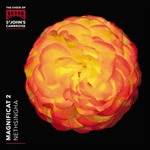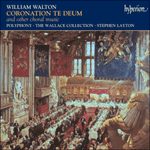
Welcome to Hyperion Records, an independent British classical label devoted to presenting high-quality recordings of music of all styles and from all periods from the twelfth century to the twenty-first.
Hyperion offers both CDs, and downloads in a number of formats. The site is also available in several languages.
Please use the dropdown buttons to set your preferred options, or use the checkbox to accept the defaults.

Walton was a perfectionistic composer, carefully weighing every note, much like his exact contemporary Maurice Duruflé—though their approaches to liturgical writing could scarcely have been more different. Walton made many revisions after the first performance of the Chichester Service. Oxford University Press had already printed the work, but the composer persuaded them not to put it on sale. When the revised version was printed and published, Walton himself paid some of the extra costs.
The organ launches us into an ecstatic choral declamation, recalling similar a capella writing in Belshazzar’s Feast. The high doubling of tenors and basses produces stunning impact at the start of the phrase, 'magnify' manages to be the biggest moment, and 'the Lord' is heard in bold-type through the use of unison. The chord on 'soul' contains five intervals of a third piled on top of each other. This is a nucleus which permeates much of the rest of the work, both harmonically and melodically, with rising thirds providing many melodic outlines (e.g. 'For he that is mighty' and 'And his mercy'.)
'And my spirit' initiates a punchy rhythmic vitality, fuelled by frequently changing time signatures. For he hath regarded portrays lowliness with a trio of lower voices. As a chorister he would have become used to such textures from mid/late seventeenth-century repertoire; they were much used as people sought to rebuild choirs during the Restoration. 'For behold from henceforth' embodies the youthful eagerness of the text. The choir seems to genuflect at 'And holy is his name'. Walton includes three iterations of 'holy' as in the Communion text Sanctus. The number three is traditionally associated with this word—think of Bach’s Sanctus in the Mass in B minor with its triplets, three oboes and three trumpets. Walton gives us mystical chords made up of notes piled up in thirds again; each chord has one more pitch than the previous one, with the bass line descending in thirds to add intensity, so that the final holy contains all seven notes of a diatonic scale. This is a favourite Walton chord, recurring at glory in the Nunc dimittis, and in other works such as The Twelve at 'starry heavens'.
As in his Coronation Te Deum (1953), Walton includes many types of antiphonal writing in the work. 'And his mercy' is reminiscent of plainsong psalm singing in its alternation of two solo voices. Often the organ provides pithy interjections between phrases—in dialogue with the choir, rather than accompanying it. Is Walton again looking back through his chorister eyes when he sets 'and hath exalted the humble and meek' for a treble solo? He contrasts this with the adult voices for putting down the mighty and leaving the rich empty-handed. Only a handful of words is repeated, and the homophonic writing contributes to the work’s concision. Despite these self-imposed constraints, Walton continually creates variety. A new dialogue of textures occurs at 'He remembering' before the organ introduces the Gloria. The Magnificat ends in a different key from that which is expected, intensifying the unbridled sense of joy.
Nunc dimittis opens with a funereal organ ostinato, with emphasis on the second of each bar’s three beats in the manner of an early eighteenth-century French Sarabande. Simeon’s text is mostly given to Bass solo or tutti before the full choir enters exuberantly to depict the 'light to lighten the Gentiles'. Again Walton revels in the theatricality of pitting choir against full organ—one thinks of the conductor Thomas Beecham saying 'why don’t you throw in two brass bands?!' before the premiere of Belshazzar’s Feast.
In my notes for Magnificat 1 I compared different ways that composers treat the two Glorias of each set of canticles. The Howells on the present recording reuses the same Gloria, but each canticle prepares for it very differently—his Magnificat ends ppp but the Nunc dimittis has a huge crescendo which surges on into the Gloria. The Walton Nunc dimittis, however, appears to be using an exact repeat of the Magnificat Gloria; then—just at the end—the composer takes an opposite turning with a soft murmuring conclusion. Most of the second Gloria reflects the glorious mood of the end of the canticle, but Walton suddenly reminds us of the dying Simeon’s rapidly diminishing strength.
from notes by Andrew Nethsingha © 2021
 Magnificat, Vol. 2 Magnificat, Vol. 2Settings of the Magnificat and Nunc dimittis by composers ranging from Herbert Howells, Sydney Watson and Herbert Sumsion through to Giles Swayne, Lennox Berkeley and Arvo Pärt—beautifully performed all.» More |
 Walton: Coronation Te Deum & other choral works Walton: Coronation Te Deum & other choral works‘An outstanding collection’ (Gramophone) ‘What a splendid work it is, especially when sung with the verve brought to it by Stephen Layton’s choir Polyphony’ (The Sunday Telegraph)» More |

